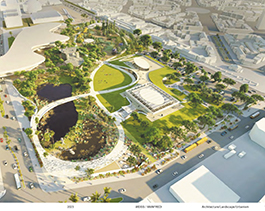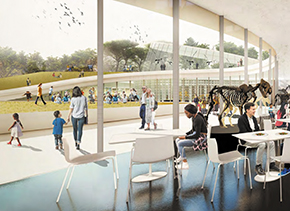Open House set for La Brea Tar Pits Master Plan Sept. 30

A NEW VISION of the planet’s most important Ice Age fossil site will include the entire 13-acre area of the museum and surrounding park in Miracle Mile.

THE PROJECT would renovate an existing 63,200-square-foot building and construct a new, two-story, 40,000-square-foot building on the La Brea Tar Pits site.
Public comments accepted until Oct. 27
Learn about proposed plans to reshape the design of the La Brea Tar Pits at an Open House for the plan on Sat., Sept. 30 from 9 to 11 a.m.
The long-discussed new vision of the planet’s most important Ice Age fossil site will include the entire 13-acre area of the museum and surrounding park in Miracle Mile.
The pop-up event on Sept. 30 will take place outdoors in Hancock Park between the George C. Page Museum entrance and the Lake Pit at 5801 Wilshire Blvd.
A Draft Environmental Impact Report for the project, La Brea Tar Pits Loops and Lenses, Master Plan and Concept Design, was released on Sept. 11. Public comments will be accepted through Thurs., Oct. 26.
Comments may be emailed to Inegritto@nhm.org or sent by mail postmarked no later than 5:30 p.m. on Oct. 26 to Natural History Museums of Los Angeles County, Attn: CFO Leslie Negritto, 900 Exposition Blvd., Los Angeles, Calif. 90007.
Step back in time
When the reimagined La Brea Tar Pits opens in 2028 (the tentative date), scientists and visitors of all ages will be able to step back in time — way back — to learn about the last major episode of global climate change and to consider possible solutions for our own time, museum officials say.
Members of New York-based architecture and design firm Weiss / Manfredi were chosen in 2019 to create the Reimagine La Brea Tar Pits master plan.
The plan calls for a dramatic expansion of the museum, built in 1977 as the George C. Page Museum. The plan nearly doubles the research and collection space.
A one-kilometer pedestrian walkway, the La Brea Loops, (aka “Miracle Kilometer in Miracle Mile”) will connect the main areas of the museum on a journey from prehistoric times to today.
The locale is, “without a doubt, one of the most extraordinary sites, subjects and settings in the world. If we think of Los Angeles as being the quintessential American city, then La Brea Tar Pits is quintessentially what is Los Angeles,” architect Marion Weiss has said in a prior interview.
Michael Manfredi added, “The master plan has evolved with the support of a great team of architects, engineers, designers, storytellers — even horticulturists and paleobotanists.”
Plan elements
The project would renovate an existing 63,200-square-foot building and construct a new, two-story, 40,000-square-foot building northwest of the Page to include two theaters.
Other key elements of the plan include a new pedestrian bridge to take visitors across the existing Lake Pit along Wilshire Blvd. and the 7.3 acres of renovated park space that will feature picnic and play areas and a possible small dog park.
The iconic mammoth sculptures currently in the lake are included in the new design, as is the popular sloped lawn down which children have been rolling for decades.
Inside, visitors will be able to peek into a glass-enclosed Fossil Lab to see ongoing discoveries and the extensive collections. On the new building’s windows, animal images will be projected at night.
Fossil remains of saber-tooth cats, giant sloths, dire wolves and other Ice Age animals who walked the grounds here 10,000 to 50,000 years ago — before being pulled into the sticky tar below — will be featured in the new exhibition building.
Shade will be added at the existing outdoor classroom and fossil dig at Pit 91, where visitors will be able to see sticky asphalt oozing up from the ground below while watching scientists work in real time.
More shade is planned to welcome visitors at the entry plaza at the corner of Wilshire Boulevard and Curson Avenue, which also will feature an Ice Age-era Pleistocene Garden. A second entryway will be on Sixth Street for school groups. Native plantings that support local wildlife and birdwatching areas will be in the park.
A rooftop café and “Tar Bar” will offer refreshments and views.
“The site is a gateway to the Ice Age, and it is right on our doorstep,” Lori Bettison-Varga, president of the Natural History Museums of Los Angeles County (NHM), told us when the project was first announced. “It gives us a very good glimpse into the last global climate change episode. Understanding what happened back then — 10,000 to 50,000 years ago — is key to finding solutions in our own time,” she added.
For more information, visit tarpits.org/reimagine.
Category: News
